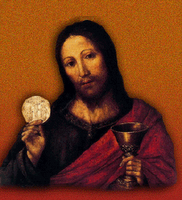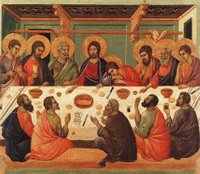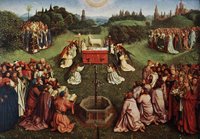Communion Practices
Q: My husband and I have long enjoyed your archives and I have a question regarding communion that I can’t find answered. We attend a Pentecostal church after leaving our previous church. We took serious study time in order to acclimate to our new environment. For communion, our current church uses bread dipped into a communal glass of grape juice. At our previous church we had individual little cups and unleavened bread pieces.
My husband feels so strongly that the bread and communal glass is wrong that we haven’t communed for a few years. That feels wrong to me. I talked to our Pastor and he said it is a ceremonial service, so the details are apt to change. What do you think about this?
 A: What I think is far less important than what Scripture teaches or what the Christian Church has practiced since its early years. But considering Christ’s institution, Paul’s teaching, and early Church practice, I find several things with which I disagree.
A: What I think is far less important than what Scripture teaches or what the Christian Church has practiced since its early years. But considering Christ’s institution, Paul’s teaching, and early Church practice, I find several things with which I disagree.Dealing first with your current church’s method of communing, this practice is called “intinction.” It’s the common means of distributing the Sacrament in Eastern Orthodoxy but generally forbidden in Roman Catholicism unless special criteria are met. Among Lutherans and Protestants of various stripes, intinction isn’t unknown but certainly is not the most common practice. The East also uses leavened bread, while the West generally maintains the Passover’s unleavened.
The Word itself and reception in true faith are vitally important. However, anything departing from the essence of the practice Jesus instituted may cause hearts to doubt even if an action isn’t actually “wrong.” Our Lord, clearly recorded by Matthew, Mark, Luke, and Paul, said “eat” and “drink.” This is explicit in the communion liturgy in most of Christendom. Our Small Catechism and hymnals use the following Words of Institution, drawn from the Synoptic Gospels and 1 Corinthians:
Our Lord Jesus Christ, on the night when He was betrayed, took bread, and when He had given thanks, He broke it and gave it to the disciples and said: “Take, eat; this is My body, which is given for you. This do in remembrance of Me.”
In the same way also he took the cup after supper, and when He had given thanks, He gave it to them, saying, “Drink of it, all of you; this cup is the new testament in My blood, which is shed for you for the forgiveness of sins. This do, as often as you drink it, in remembrance of Me.”
For these reasons, intinction is not something I prefer, although I do not chase away someone who does it at my church’s altar.
As for the vessel, I think that using the common cup (or chalice) comes closest to what Christ did and is the best testimony to the unity of the Lord’s Supper. Of course, we have many more people communing than Jesus did that first night, so the Church needs to distribute more than any normal cup can hold. You note that this took place in your former church with the use of individual cups. I think we hold more closely to Scripture if we use one cup and refill it as needed.
The use of one cup per communicant is a very recent innovation in Christendom. Other than fear of germs or discomfort over personal contact with our fellow believers, what could move us away from the continued use of one cup for all? Is either fear or discomfort an excuse that stands up in light of God’s Word? Or does using individual cups confess people’s doubts that what they receive is truly and completely a “cup of blessing (1 Corinthians 10:16)”?
 Another reason also intrudes — expediency. It takes longer to commune using one cup than to hand out individual cups or to use multiple chalices. This meal, eaten and drunk “in remembrance (1 Corinthians 11:24-25)” of Christ’s suffering and death, too often sits under the scrutiny of clock-watching congregants who worry that the service might go over-long. I can’t imagine Jesus (had wristwatches been available) glancing down and saying, “Can you fellows hurry up? I’ve got to go get arrested.” Nor can I fathom early believers — who realized that they might be arrested and killed at any time — trying to speed up the Sacrament so they could leave more quickly.
Another reason also intrudes — expediency. It takes longer to commune using one cup than to hand out individual cups or to use multiple chalices. This meal, eaten and drunk “in remembrance (1 Corinthians 11:24-25)” of Christ’s suffering and death, too often sits under the scrutiny of clock-watching congregants who worry that the service might go over-long. I can’t imagine Jesus (had wristwatches been available) glancing down and saying, “Can you fellows hurry up? I’ve got to go get arrested.” Nor can I fathom early believers — who realized that they might be arrested and killed at any time — trying to speed up the Sacrament so they could leave more quickly.This isn’t to say that those who commune using multiple chalices or individual cups do not receive the blood of Jesus Christ. However, these practices do not confess unity among the believers and between the Church and her Lord as fully as does a cup from which all drink.
Furthermore, if you’ve been reading this column for a while, you’ve encountered my Bible-based certainty that what’s in the cup should be wine, not grape juice. This latter beverage was unknown in Jesus’ time, particularly at the Passover, when there would be no fresh grapes to squeeze and no means of preserving unfermented juice existed. (Previous posts mentioning wine and Holy Communion include Alcohol in Holy Communion and Communion Wine.)
A recent post from Gottesblog concurs. The author flatly states that those who receive grape juice do not receive the forgiveness of sins granted in the Lord’s Supper because, “if you change the elements of the Sacrament, you don’t have the Sacrament, and if you don’t have the Sacrament, you don’t have Christ.”
I’m also uncomfortable with your pastor’s statement that communion “is a ceremonial service, so the details are apt to change.” Yes, we receive Holy Communion within a ceremony, but it’s a ceremony that does something. It not only remembers Jesus’ suffering and death, it also gives us the benefits of His sacrifice. Weddings are ceremonies, but what if they changed to only talking about marriage and discarded the “detail” of legally binding man and woman as husband and wife?
Jesus took bread and said, “This is My body. (Matthew 26:26)” He took a cup of wine and said, “This is My blood. (Matthew 26:28)” He chose these two earthly elements to give us His own flesh and blood to eat and to drink. These “details” were unchanged through over 1900 years of Church history, although there were places and times when the cup was sinfully withheld from the lips of the laity and allowed only to the clergy.
 Some churches change other details, also. Counter to Jesus’ plain words, they invent fanciful reasons why the body and blood of Christ in the Holy Supper are not really His body and blood. They speak of “symbolic” or “spiritual” eating and drinking instead of simply receiving with thanksgiving what Jesus says He gives us.
Some churches change other details, also. Counter to Jesus’ plain words, they invent fanciful reasons why the body and blood of Christ in the Holy Supper are not really His body and blood. They speak of “symbolic” or “spiritual” eating and drinking instead of simply receiving with thanksgiving what Jesus says He gives us.Yes, the Sacrament includes symbolism — its very institution during Passover was itself symbolic. And yes, Christ effects spiritual change among the communicants. Yet the symbols should never obscure the substance: In Holy Communion we eat and drink the body and blood of Jesus Christ as we eat and drink ordinary bread and wine. As the Lord says, so it is.
Scripture quoted from The Holy Bible, English Standard Version™, © 2001 by Crossway Bibles.
Send email to Ask the Pastor.
Walter Snyder is the pastor of Holy Cross Lutheran Church, Emma, Missouri and coauthor of the book What Do Lutherans Believe.
Technorati Tags: Holy Communion | Lord’s Supper | Communion | intinction | Small Catechism

2 Comments:
In the practice of communion, doesn't the Bible say not to drink blood? So in practicing communion you are going against the Bible? Also are you continuing "eternal sacrifice" with communion even though Christ was the final sacrifice. The Old Testament is against this and God looks very unfavorable upon this as stated in Leviticus 17:10 And any man from the house of Israel, or from the aliens who sojourn among them, who eats any blood, I will set My face against that person who eats blood and will cut him off from among his people.
If you are looking for personalised communion gifts check it out :
http://www.yoursurprise.co.uk/gift/communion
I just found it and may make you all smile a little bit more :)
Post a Comment
<< Home